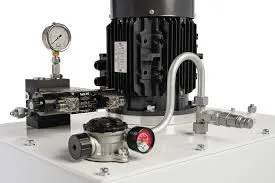Nov . 26, 2024 19:15 Back to list
Reconstruction of Hydraulic Cylinder Manufacturing Process for Enhanced Performance and Reliability
Rebuilding Hydraulic Cylinders A Comprehensive Guide
Hydraulic cylinders are essential components in a wide range of machinery, from construction equipment and agricultural machines to manufacturing systems. Over time, these cylinders can wear out or become damaged due to various factors such as excessive pressure, exposure to contaminants, or wear and tear from regular use. When this happens, rebuilding rather than replacing the hydraulic cylinder can be a cost-effective solution that restores functionality and extends the life of your equipment. This article delves into the rebuilding process of hydraulic cylinders, its benefits, and what to consider when working with a hydraulic cylinder factory.
Understanding the Rebuilding Process
Rebuilding a hydraulic cylinder typically involves disassembly, inspection, cleaning, replacement of worn or damaged parts, and reassembly. Here’s a step-by-step overview of the crucial stages involved
1. Disassembly The first step is to safely disassemble the hydraulic cylinder. This involves removing the cylinder from its mounting and breaking it down into its core components, including the barrel, piston, rod, seals, and end caps. Ensuring safety during disassembly is vital, as hydraulic pressure can still be present.
2. Inspection Once disassembled, each component should be thoroughly inspected for signs of wear, cracking, and other damage. This includes checking the cylinder bore for scratches or pitting, inspecting the piston and seals for wear, and evaluating the rods for straightness and surface quality.
3. Cleaning Proper cleaning is essential to remove any contaminants that could affect the performance of the hydraulic cylinder. Specialized cleaning solutions and methods may be employed, especially for components that have been subject to significant build-up or contamination.
4. Replacement Parts After inspection, any defective parts that cannot be repaired should be replaced with high-quality components. Seals and O-rings, in particular, are common items that require replacement, as they are crucial to maintaining hydraulic pressure. It’s important to source parts from reputable manufacturers to ensure compatibility and durability.
5. Reassembly Once all components are cleaned and any replacements made, the hydraulic cylinder can be reassembled. Care must be taken to follow the original manufacturer’s specifications for torque settings and assembly procedures to ensure the cylinder functions as intended.
6. Testing Before returning the rebuilt cylinder to service, it should undergo rigorous testing. This step verifies that the cylinder operates efficiently and safely under pressure, ensuring there are no leaks and that performance meets operational standards.
Benefits of Rebuilding Hydraulic Cylinders
Rebuilding hydraulic cylinders can offer several advantages
rebuild hydraulic cylinder factory

- Cost-Effectiveness Rebuilding is often significantly cheaper than purchasing a new cylinder, particularly for large or specialized hydraulic systems where new cylinders might be costly or hard to find.
- Environmental Impact Rebuilding helps reduce waste by extending the life of existing components, contributing to a more sustainable approach in industries that depend heavily on hydraulic systems.
- Enhanced Performance A well-rebuilt hydraulic cylinder can often perform better than its original state, especially if upgraded seals and components are used during the process.
- Quick Turnaround Many hydraulic cylinder factories offer fast turnaround times for rebuilding services, minimizing downtime for your machinery.
Choosing the Right Hydraulic Cylinder Factory
When selecting a hydraulic cylinder factory for rebuilding, consider the following factors
- Expertise and Reputation Look for a factory with extensive experience in hydraulic cylinder rebuilds and positive customer reviews.
- Quality of Parts Ensure they use high-quality replacement parts and follow stringent quality control measures.
- Customization Some factories can offer customization options for specific needs, which can be beneficial for specialized applications.
- Warranty and Support A good factory will provide a warranty on their work and be available for support if any issues arise post-repair.
In conclusion, rebuilding hydraulic cylinders is a practical solution for maintaining machinery efficiency and reducing costs. By understanding the rebuilding process and choosing the right factory, businesses can ensure optimal performance and longevity of their hydraulic systems.
-
Fork Lift Power Units - Hebei Shenghan | Efficiency, Reliability
NewsJul.13,2025
-
1.5-Ton Turbocharged Cylinder-Hebei Shenghan|Hydraulic Solution,Energy Efficiency
NewsJul.13,2025
-
Auto Hoist Power Units-Hebei Shenghan|Efficiency&Industrial Lifting
NewsJul.13,2025
-
Double Acting Power Units-Hebei Shenghan|Hydraulic Solutions,Industrial Efficiency
NewsJul.13,2025
-
1.5 Ton Lifting Cylinder 70/82-40-290-535 - High-Performance Hydraulic Solution | Hebei Shenghan
NewsJul.13,2025
-
Fork Lift Power Units - Hebei Shenghan | Efficiency&Reliability
NewsJul.13,2025
